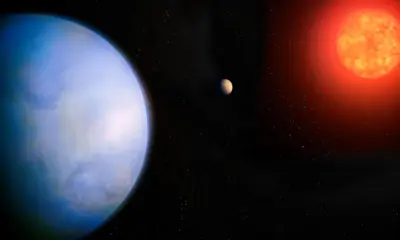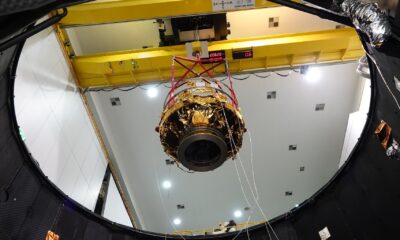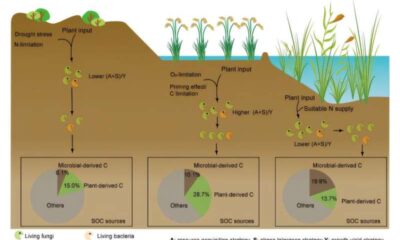Science
Chang’e-6 Research Reveals Ancient Meteorite Role in Water Delivery

Recent findings from the Chang’e-6 mission indicate that ancient meteorites played a crucial role in delivering water to both Earth and the Moon. A research team from the Chinese Academy of Sciences (CAS) analyzed samples collected from the far side of the Moon, revealing that these meteorites, specifically Carbonaceous Ivuna-type (CI) chondrites, contributed to the lunar regolith.
Meteorites serve as valuable time capsules, preserving the chemical composition of their origins. They are fragments from larger asteroids or debris from impacts on other celestial bodies. Unlike meteorites found on Earth, which undergo erosion and other geological processes, lunar meteorites remain largely intact due to the Moon’s lack of atmosphere and geological activity. This preservation allows scientists to study these materials for insights into the early Solar System.
The CAS research team, led by Professors Xu Yigang and Lin Mang, collaborated with experts from institutions including Brown University and Vrije Universiteit Brussel. Their paper, published in the Proceedings of the National Academy of Sciences on October 20, 2023, details the identification of seven olivine-bearing minerals in the lunar samples. These minerals were confirmed to have originated from CI chondrites, a type of meteorite known for its fragile structure and significance in understanding the delivery of water and organic materials in the Solar System.
CI chondrites, characterized by their carbon content, account for less than 1% of meteorite samples analyzed on Earth. Their low survival rate during atmospheric entry makes them rare, but the lunar environment allows for their preservation. The research highlights the importance of studying these meteorites to reconstruct the primordial accretion history and impactor population of the inner Solar System.
The team found that the lunar samples were formed from molten droplets created by high-velocity impacts, which then cooled rapidly in space. Using textural characterization and in-situ analysis of triple oxygen isotopes, the researchers determined that these CI-like chondrites struck the Moon before the Nectarian Period, approximately 3.92 billion years ago. This timeframe aligns with the Late Heavy Bombardment, a period marked by an increased frequency of asteroid and comet impacts in the inner Solar System.
Research indicates that these impacts were significant in introducing water and organic molecules to the inner Solar System. The findings suggest that CI chondrites may have played a more substantial role in shaping the Earth-Moon system than previously acknowledged. The samples support the hypothesis that these meteorites contributed water and organic materials essential for the development of life.
The study also proposes that previously detected water ice deposits on the Moon, which displayed specific positive oxygen isotopes, were likely delivered by CI chondrites. This connection further emphasizes the importance of meteorites in understanding the evolution of our planetary environment.
In addition to their findings, the CAS team conducted a preliminary statistical analysis of meteoritic materials, suggesting a greater influence of CI chondrites in the early Solar System than previously thought. The methodologies developed in this research may serve as a valuable framework for assessing other extraterrestrial samples in future missions.
This research not only sheds light on the history of water delivery in our Solar System but also opens new avenues for exploration and understanding of the conditions that led to life on Earth. As scientists continue to analyze lunar samples and other extraterrestrial materials, the insights gained will significantly enhance our knowledge of planetary formation and evolution.
-

 Technology4 months ago
Technology4 months agoDiscover the Top 10 Calorie Counting Apps of 2025
-

 Health2 months ago
Health2 months agoBella Hadid Shares Health Update After Treatment for Lyme Disease
-

 Health3 months ago
Health3 months agoErin Bates Shares Recovery Update Following Sepsis Complications
-

 Technology3 weeks ago
Technology3 weeks agoDiscover 2025’s Top GPUs for Exceptional 4K Gaming Performance
-

 Technology2 months ago
Technology2 months agoElectric Moto Influencer Surronster Arrested in Tijuana
-

 Technology4 months ago
Technology4 months agoDiscover How to Reverse Image Search Using ChatGPT Effortlessly
-

 Technology4 months ago
Technology4 months agoMeta Initiates $60B AI Data Center Expansion, Starting in Ohio
-

 Technology4 months ago
Technology4 months agoRecovering a Suspended TikTok Account: A Step-by-Step Guide
-

 Health4 months ago
Health4 months agoTested: Rab Firewall Mountain Jacket Survives Harsh Conditions
-

 Lifestyle4 months ago
Lifestyle4 months agoBelton Family Reunites After Daughter Survives Hill Country Floods
-

 Technology3 months ago
Technology3 months agoUncovering the Top Five Most Challenging Motorcycles to Ride
-

 Technology4 weeks ago
Technology4 weeks agoDiscover the Best Wireless Earbuds for Every Lifestyle





















